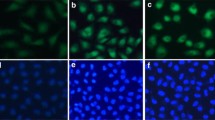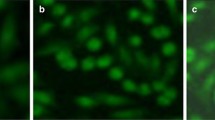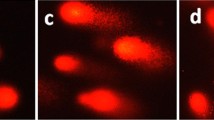Abstract
This study was intended to evaluate the anticancer activity of three newly synthesized iridium(III) complexes [Ir(ppy)2(PEIP)](PF6) (1) (ppy = 2-phenylpyridine, PEIP = 2-phenethyl-1H-imidazo[4,5-f][1,10]phenanthroline), [Ir(ppy)2(SIP)](PF6) (2) (SIP = (E)-2-styryl-1H-imidazo[4,5-f][1,10]phenanthroline) and [Ir(ppy)2(PEYIP)](PF6) (3) (PEYIP = 2-phenethynyl-1H-imidazo[4,5-f][1,10]phenanthroline). The cytotoxic activity in vitro against A549, SGC-7901, HepG2, HeLa and normal NIH3T3 cells was investigated by 3-(4,5-dimethylthiazole-2-yl)-2,5-diphenyl tetrazolium bromide (MTT) method. We found that the complexes 1, 2 and 3 significantly inhibited cell proliferation, in particular, complexes 2 and 3 show high cytotoxic effect on SGC-7901 cells with an IC50 value of 5.8 ± 0.7 and 4.4 ± 0.1 μM. Moreover, cell cycle assay revealed that the complexes could block G2/M phase of the cell cycle. Apoptotic evaluation by Annexin V/PI staining indicated that complexes 1–3 can induce apoptosis in SGC-7901 cells. In addition, microscopy detection suggested that disruption of mitochondrial functions, characterized by increased generation of intracellular ROS and Ca2+ as well as decrease of mitochondrial membrane potential. Western blot analysis shows that the complexes upregulate the expression of pro-apoptotic Bax and downregulate the expression of anti-apoptotic Bcl-2, which further activates caspase-3 and prompts the cleavage of PARP. Taken together, these results demonstrated that complexes 1–3 exert a potent anticancer effect on SGC-7901 cells via ROS-mediated endoplasmic reticulum stress-mitochondrial apoptotic pathway and have a potential to be developed as novel chemotherapeutic agents for human gastric cancer.
Graphical abstract
Three new iridium(III) complexes [Ir(ppy)2(PEIP)](PF6) (1) (ppy = 2-phenylpyridine, PEIP = 2-phenethyl-1H-imidazo[4,5-f][1,10]phenanthroline), [Ir(ppy)2(SIP)](PF6) (2) (SIP = 2-styryl-1H-imidazo[4,5-f][1,10]phenanthroline) and [Ir(ppy)2(PEYIP)](PF6) (3) (PEYIP = 2-phenethynyl-1H-imidazo[4,5-f][1,10]phenanthroline) were synthesized and characterized. The anticancer activity in vitro was investigated by 3-(4,5-dimethylthiazole-2-yl)-2,5-diphenyl tetrazolium bromide (MTT) method. The results show that the complexes induce apoptosis via ROS-mediated endoplasmic reticulum stress-mitochondrial dysfunction pathway.










Similar content being viewed by others
Abbreviations
- A549:
-
Human lung carcinoma
- apip:
-
2-Aminophenyl-1H-imidazo[4,5-f][1,10]phenanthroline
- Annexin V:
-
3′,6′-dihydroxy-5-isothiocyanato-3H-spiro(isobenzofuran-1,9′-xanthen)-3-one
- Bax:
-
Bcl-2 associated x protein
- BCA:
-
Bicinchoninic acid
- Bcl-2:
-
B-cell lymphoma-2
- BEL-7402:
-
Human hepatocellular
- bpy:
-
2,2′-Bipyridine
- CCCP:
-
Carbonylcyanide-m-chlorophenylhydrazone
- CFPIP:
-
(E)-2-(4-Fluorostyryl)-1H-imidazo [4,5-f][1,10]phenanthroline
- DAPI:
-
2-(4-Amidinophenyl)-6-indolecarbamidine dihydrochloride
- DCFH:
-
2′,7′-Dichloro-3,6-fluorandiol
- DCFH-DA:
-
2′,7′-Dichlorodihydrofluorescein diacetate
- DCF:
-
Dichlorofluorescein
- DMEM:
-
Dulbecco’s Modified Eagle Medium
- DMSO:
-
Dimethylsulfoxide
- EDTA:
-
Ethylene diamine tetraacetic acid
- FBS:
-
Fetal bovine serum
- Fluo-3AM:
-
Fluo-3-pentaacetoxymethyl ester
- HepG2:
-
Human hepatocellular carcinoma
- JC-1:
-
5,5′,6,6′-Tetrachloro-1,1′,3,3′-tetrethylbenzimidalylcarbocyanine iodide
- MTT:
-
3-(4,5-Dimethylthiazole)-2,5-diphenyltetraazolium bromide
- NIH3T3:
-
Mouse embryonic fibroblast
- PARP:
-
Poly ADP-ribose polymerase
- PBS:
-
Phosphate buffer saline
- PEIP:
-
2-Phenethyl-1H-imidazo[4,5-f][1,10]phenanthroline
- PEYIP:
-
2-Phenylethynyl-1H-imidazo[4,5-f][1,10]phenanthroline
- PI:
-
Propidium iodide
- piq:
-
1-Phenylisoquinoline
- ppy:
-
2-Phenylpyridine
- ROS:
-
Reactive oxygen species
- RPMI 1640:
-
Roswell Park Memorial Institute 1640
- SGC-7901:
-
Human gastric adenocarcinoma
- SIP:
-
(E)-2-styryl-1H-imidazo[4,5-f][1,10]phenanthroline
- TBST:
-
20 mM Tris–HCl, 150 mM NaCl, 0.05% Tween 20, pH 8.0
- Tris:
-
Tris(hydroxymethyl)aminomethane
- Tween:
-
Polyoxyethylene monolaurate sorbaitan
References
Pan ST, Li ZL, He ZX, Qiu JX, Zhou SF (2016) Clin Exp Pharmacol Physiol 43:723–737
Galluzzi L, Senovilla L, Vitale I, Michels J, Martins I, Kepp O, Castedo M, Kroemer G (2012) Oncogene 31:869–1883
Shen DW, Pouliot LM, Hall MD, Gottesman MM (2012) Pharmacol Rev 64:706–721
Kelland L (2007) Nat Rev Cancer 7:573–584
Jung Y, Lippard SJ (2007) Chem Rev 107:1387–1407
Markman M (2003) Expert Opin Drug Saf 2:597–607
Bruijninc PC, Sadler PJ (2008) Curr Opin Chem Biol 12:197–206
Li Y, Wang KN, He L, Ji LN, Mao ZW (2020) J Inorg Biochem 205:110796
Bai L, Fei WD, Gu YY, He M, Du F, Zhang WY, Yang LL, Liu YJ (2020) J Inorg Biochem 205:11014
Liu XC, Chen SJ, Ge XX, Zhang Y, Xie YQ, Hao YY, Wu DQ, Zhang JM, Yuan XA, Tian LJ, Liu Z (2020) J Inorg Biochem 205:110983
Peng W, Hegazy AM, Jiang N, Chen X, Qi HX, Zhao XD, Pu J, Ye RR, Li RT (2020) J Inorg Biochem 203:110909
He M, Yi QY, Zhang WY, Bai L, Du F, Gu YY, Liu YJ, Wei P (2019) New J Chem 43:8566–8579
Zhang WY, Wang YJ, Du F, He M, Gu YY, Bai L, Yang LL, Liu YJ (2019) Eur J Med Chem 178:401–416
Ma WL, Zhang SM, Tian ZZ, Xu ZS, Zhang YJ, Xia XR, Chen XB, Liu Z (2019) Eur J Med Chem 181:111599
Gilewska A, Barszcz B, Masternak J, Kazimierczuk K, Sitkowski J, Wietrzyk J, Turlej E (2019) J Biol Inorg Chem 24:591–606
Tang B, Wan D, Wang YJ, Yi QY, Guo BH, Liu YJ (2018) Eur J Med Chem 145:302–314
Zhang HW, Tian L, Xiao RX, Zhou Y, Zhang YY, Hao J, Liu YJ, Wang JP (2021) Bioorganic Chem 115:105290
Zhang YY, Fei WD, Zhang HW, Zhou Y, Tian L, Hao J, Yuan YH, Li WL, Liu YJ (2021) J Inorg Biochem 225:111622
Zhang YY, Zhou Y, Zhang HW, Tian L, Hao J, Yuan YH, Li WL, Liu YJ (2021) J Inorg Biochem 224:111580
Hao J, Zhang HW, Tian L, Yang LL, Zhou Y, Zhang YY, Liu YJ, Xing DG (2021) J Inorg Biochem 221:111465
Zhou Y, Bai L, Tian L, Yang LL, Zhang HW, Zhang YY, Hao J, Gu YY, Liu YJ (2021) J Inorg Biochem 223:111550
Gu YY, Wen HY, Zhang YY, Bai L, Zhou Y, Zhang HW, Tian L, Hao J, Liu YJ (2021) J Biol Inorg Chem 26:109–122
Fulda S (2011) Front Oncol 1:23
Nhu D, Lessene G, Huang DCS, Burns CJ (2016) Med Chem Commun 7:778–787
Antkowiak WZ, Sobczak A (2001) Tetrahedron 57:2799–2805
Calderazzo F, Pampaloni G, Passarelli V (2002) Inorg Chim Acta 330:136–142
Ma GL, Bi XD, Gao F, Feng Z, Zhao DC, Lin FJ, Yan R, Liu DD, Liu P, Chen JB, Zhang HB (2018) J Inorg Biochem 185:1–9
Lei XW, Wang HY, Feng YR, Zhang JX, Sun XJ, Lai SM, Wang ZL, Kang S (2015) RSC Adv 5:1–12
Sprouse S, King KA, Spellane PJ, Watts RJ (1984) J Am Chem Soc 106:6647–6653
Berridge MV, Tan AS (1993) Arch Biochem Biophys 303:474–482
Tim M (1983) J Immunol Methods 65:55–63
Manallack DT (2007) Perspect Med Chem 1:81–102
Fischer H, Gottschlich R (1998) J Membr Biol 165:201–211
Jiang GB, Zhang WY, He M, Gu YY, Bai L, Wang YJ, Yi QY, Du F (2021) J Inorg Biochem 225:111616
Yuan YH, Shi CL, Wu XY, Li WL, Wang CX, Liang LJ, Chen J, Wang Y, Liu YJ (2022) J Inorg Biochem 232:111820
Wang C, Jiang LP, Wang SQ, Shi HG, Wang JW, Ran W, Li YM, Dou YH, Liu Y, Hou GQ, Ke Y, Liu HM (2015) PLOS One 10:1–23
Etti I, Rasedee A, Hashim NM, Abdul ABB, Kadir AA, Yeap SK, Waziri P, Malami I, Lim KL, Etti C (2017) Drug Design Dev Therapy 11:865–879
Circu ML, Yee AT (2010) Free Radic Biol Med 48:749–762
Simon HU, Yehia AH, Schaffer FL (2000) Apoptosis 5:415–418
Xie XM, Deng T, Duan JF, Xie J, Yuan JL, Chen MQ (2020) Ecotox Environ Saf 190:110133
Sui XB, Kong N, Ye L, Han WD, Zhou JC, Zhang Q, He C, Pan HM (2014) Cancer Lett 344:174–179
Cui L, Bu WQ, Song J, Feng L, Xu TT, Liu D, Ding WB, Wang JH, Li CY, Binge M, Luo Y, Jiang ZY, Wang CC, Chen J, Hou J, Yan HM, Yang L, Jia XB (2018) Arch Pharm Res 41:299–313
Berridge MJ, Lipp P, Bootman MD (2000) Nat Rev Mol Cell Biol 1:11–21
Marchi S, Patergnani S, Missiroli S, Morciano G, Rimessi A, Wieckowski MR, Giorgi C, Pinton P (2018) Cell Calcium 69:62–72
Krebs J, Agellon LB, Michalak M (2015) Biochem Bioph Res Commun 460:114–121
Adler J, Parmryd I (2010) Cytom Part A 77A:733–742
Yu SJ, Zhang LP, Liu C, Yang J, Zhang JH, Huang L (2019) Exp Cell Res 379:191–202
Gu YY, Wen HY, Bai L, Zhou Y, Zhang HW, Tian L, Zhang YY, Hao J, Liu YJ (2020) J Inorg Biochem 211:111215
Perelman A, Wachtel C, Cohen M, Haupt S, Shapiro H, Tzur A (2012) Cell Death Dis 3:e430
Geng Y, Zhong Y, Zhou Q, Chen SQ, Piao Y, Yin W, Lu H, Shen YQ (2019) Chem Commun 55:10015–10018
Qi GH, Wang B, Zhang Y, Li HJ, Li CP, Xu WQ, Jin YD (2019) Anal Chem 91:9571–9579
Li X, Fang F, Gao Y, Tang G, Xu WQ, Wang YH, Kong RX, Ayixianguli T, Wang ZC (2019) Oxid Med Cell Longev 2019:4528616
Ma ZJ, Lu L, Yang JJ, Wang XX, Su G, Wang Z, Chen GH, Sun HM, Wang MY, Yang Y (2018) Eur J Pharm 821:1–10
Brentnall M, Rodriguez-Menocal L, Guevara RLD, Cepero E, Boise LH (2013) BioMed Central 14:32
Yang Y, Zong M, Xu W, Zhang Y, Wang B, Yang M, Tao L (2017) Chem Biol Interact 262:38–45
Yu J, Ji H, Dong X, Feng Y, Liu A (2019) Int J Biol Macromol 126:811–819
Acknowledgements
This work was supported by the National Nature Science Foundation of China (No 21877018).
Funding
National Natural Science Foundation of China,21877018
Author information
Authors and Affiliations
Corresponding authors
Ethics declarations
Conflict of interest
Authors declare no competing interest exists.
Additional information
Publisher's Note
Springer Nature remains neutral with regard to jurisdictional claims in published maps and institutional affiliations.
Supplementary Information
Below is the link to the electronic supplementary material.
Rights and permissions
About this article
Cite this article
Wang, J., Liu, H., Wu, X. et al. Induction of apoptosis in SGC-7901 cells by iridium(III) complexes via endoplasmic reticulum stress-mitochondrial dysfunction pathway. J Biol Inorg Chem 27, 455–469 (2022). https://doi.org/10.1007/s00775-022-01943-6
Received:
Accepted:
Published:
Issue Date:
DOI: https://doi.org/10.1007/s00775-022-01943-6




